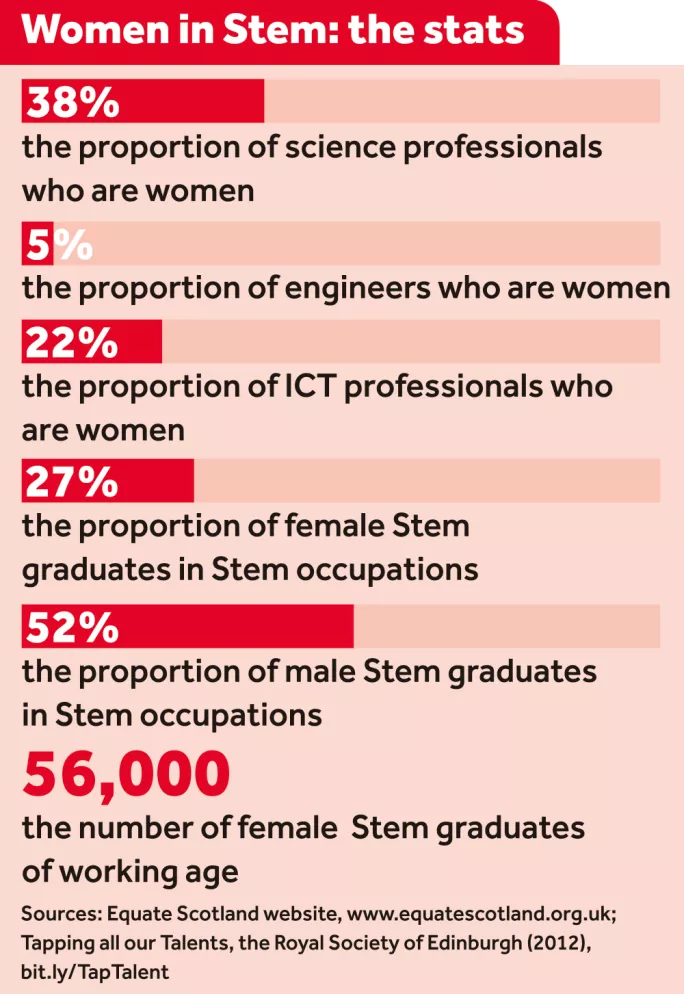Geologist digs deep to get more girls into science

This time last year, Amanda Gray was on an isolated onshore oil rig in Kazakhstan surrounded by snow - and men. She felt acutely aware of her gender.
As a geologist working in the oil and gas industry, her situation reflected the fact that women working in science, technology, engineering and maths (Stem) areas are hugely outnumbered by men.
That is why Gray has signed up to bring Stemettes - the organisation originally founded in England in 2013 to show the next generation of women that they can “do science” - to Scotland.
Gray is calling on schools to address gender bias at the earliest opportunity, and for the government and Stem companies to support them to do it. There needs to be more funding for school mentoring programmes and better careers advice to get girls into Stem, she says.
Girls can also be overshadowed by boys at mixed schools, she argues, because they do not feel as free “to goof out, play around and get hands on”. For that reason, Gray feels there needs to be more “safe spaces” outside of school for girls to engage with science.
‘If girls are only exposed to role models as princesses, how are they going to be able to believe that they can be a naval architect who builds aircraft carriers?’
“Young people need to be made aware of what has already been ingrained in them about what is possible and to be taught to think differently,” she says. “Gender social norms are slowly fed in throughout a child’s life, from the toys they are given and the things they are exposed to do, to the movies they watch.
“If girls are only exposed to role models as princesses, how are they going to be able to believe that they can be a naval architect who builds aircraft carriers?”
Gray, who was brought up in Shetland, was good at geography and science at school, but says it was never suggested to her that she could pursue science as a career. She decided that for herself, after being inspired by Sir David Attenborough’s BBC programmes.
She only discovered that there was “this thing called geology” when flicking through a university prospectus. “I did not know geology - this middle ground between science and geography - existed.”
“I’ve always felt quite strongly about young people having good career advice because your career isn’t just a career, it’s your life,” says Gray. “And there’s so much out there, but there are not enough people coming in and letting young people know about it, and giving them the experiences that will allow them to make good decisions [is important].”

Space for girls to explore
She ended up studying geology and petroleum geology at the University of Aberdeen and went on to work for a small oil company, where she was tasked with uncovering where the ancient rivers and beaches of the Jurassic period were, in order to find more oil and gas.
But when the price of oil plummeted in 2015 the industry was thrown into uncertainty, and she joined Stemettes in December.
Earlier this week, she spoke about getting more women into science at the Stem Scotland conference in Edinburgh, where the Scottish government discussed its plans to encourage more girls to get into Stem.
Stemettes’ first foray north of the border came in September, when it held its Monster Confidence event in Glasgow, an informal conference event for teenage girls, with keynote speakers, workshops on CV writing and interview techniques, and speed mentoring so that girls could meet women working in Stem.
‘We like to create a safe space for girls away from school and the overarching gender social norms’
Last weekend, Stemettes held its first “hackathon” - an intensive computer-programming session - in Paisley at the University of the West of Scotland, teaching girls from the age of 5 to 22 about designing their own news websites and apps, with “fake news” as a theme.
Gray says: “We like to create a safe space for girls away from school and the overarching gender social norms, where they can discover and explore their own love for Stem and be their own bright sparks.”
Three rules govern Stemette events - they have to be fun, free and involve food. But to make them free of charge requires sponsorship from government or industry, and securing that will secure Stemettes’ future in Scotland, says Gray.
But she will be grappling with that challenge at the same time as she embarks on a PhD - “I needed to make sure I was one of these women doing science, too - not just talking about it,” she says.
For more information, go to stemettes.org
You need a Tes subscription to read this article
Subscribe now to read this article and get other subscriber-only content:
- Unlimited access to all Tes magazine content
- Exclusive subscriber-only stories
- Award-winning email newsletters
Already a subscriber? Log in
You need a subscription to read this article
Subscribe now to read this article and get other subscriber-only content, including:
- Unlimited access to all Tes magazine content
- Exclusive subscriber-only stories
- Award-winning email newsletters